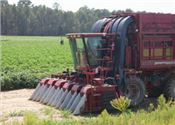|
MS Cotton Has A Strong Boll Set Nearing Harvest

Mississippi’s cotton crop, while planted on fewer acres this year, looks to be in good condition with a strong boll load as of
early September. This cotton was growing in Webster County, Mississippi, Sept. 3, 2020.
Photo by MSU Extension Service/Kevin Hudson
STARKVILLE, MISS.
Mississippi has a good-looking cotton crop in most places, but acreage is down to 520,000 acres because of a rainy planting season and unfavorable market conditions.
The U.S. Department of Agriculture on Aug. 31 estimated 65 percent of the state’s crop to be in good or excellent condition. The rest is considered fair, with just 8 percent in poor condition. State growers planted 680,000 acres of cotton in 2019, 26 percent more than this year’s acreage.
Brian Pieralisi, cotton specialist with the Mississippi State University Extension Service, said much of the state’s cotton is loaded with bolls.
“This year, we were able to get most of our acres in on time, and then we entered a weather pattern of a lot of rain before it got dry again,” Pieralisi said. “This pattern allowed a really good root system to develop in a lot of places and allowed growers to address most weed issues.”
Thrips were unusually bad in many places, and there were hot spots of significant bollworm and plant bug activity, but Pieralisi said these pest problems were manageable when detected and treated on time.
“We really had some pretty favorable weather and have not had a lot of fruit shed,” Pieralisi said.
He said most of the cotton in the state’s prairie region appears to be in good shape, but some in that area and in the northeastern part of the state experienced repeated, excessive rainfall. Those plants did not establish a good root system, and this acreage is not performing as well as some other areas.
The state’s cotton dodged a bullet by avoiding excessive rainfall brought to some places by Hurricane Laura and Tropical Storm Marco. Growers should begin spraying defoliants by the second week of September, and harvest will begin about two weeks after that.
“We usually count on the whole month of October for harvest, and we need the sun to shine,” Pieralisi said. “heat units will help finish out the top crop and later planted cotton.”
A good harvest still needs good market prices before the crop can truly have a good year.
Will Maples, an Extension agricultural economist specializing in row crops, said the market for cotton did not look good early in the year with the COVID-19 pandemic, but it has come back stronger than anticipated.
"December futures are trading around 65 cents a pound, which is up from the March low of near 50 cents a pound,” Maples said. “These are not great prices, but it is at least back to break-even for producers.”
These prices match 2019 prices, but they are down from the 2018 price of 70 cents a pound.
Maples said cotton and cotton products are discretionary items for many consumers, and the pandemic-fueled economic downturn adversely affected their markets.
“Consumer spending on apparel has strengthened since the shutdowns earlier this year but remain lower than the previous year,” he said. “Since the shutdowns, the driver of price has been questions around U.S. acreage.”
2020 cotton acreage in the U.S. is down from the previous two years, and there is uncertainty around the size of the west Texas crop this year because of drought conditions and concerns about the impact of the recent hurricanes in Louisiana. ∆
|
|